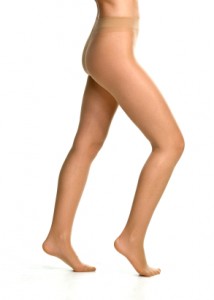Most of us recognize that nylon stockings and pantyhose have been a hit for more than half a century and reached their peak popularity during the time when miniskirts became the rage.
Later, during the 1980s and beyond, nylon hosiery experienced a steady decline and rejection by women of all ages and walks of life.
Droves of women suddenly had decided that bare legs with a natural or man-made tan was better than the formal polished look of pantyhose.
It wasn’t until very recently that pantyhose experienced a true fashion renaissance fueled to a significant degree by English royalty Kate Middleton’s regular public appearances wearing fashionable hosiery.
The hybrid cousins of pantyhose, also known as support pantyhose and support stockings, have enjoyed much more of an evergreen status among their loyal wearers. This is upheld by the potential health benefits of support hosiery rather than what is “In” or “Out” on the runway at any given time.
Coming back to the question whether support pantyhose are good or bad for you, we would have to conclude similar to the old adage of “One size does not fit all”; it really depends on your individual situation.
To illustrate this further, in the following we will try to shed some light on the positives and the negatives of wearing support pantyhose and stockings so you may draw your own conclusions on what could work best for you.
How Are Support Pantyhose Good for You?
Even if we are generally healthy, wearing support hose could be considered preventative care or therapy for a number of specific ailments and bothersome conditions we may experience simply from doing the tasks and activities of our daily living.
This can include the following complaints or discomforts:
- Aching legs
- Heavy feeling legs
- Tired feeling legs
- Painful or cramping legs
In addition they can help with:
- Boosting the blood circulation in the legs
- Preventing new and possibly improving existing spider veins
- Possibly preventing new and lessen the appearance of existing cellulite
- Preventing and possibly reducing swelling of the feet and ankles (cankles)
- Concealing skin blemishes and imperfections for a finished look
- Eliminating or reducing symptoms of restlessness in the legs
- Relieving unpleasant sensations in the legs and feet
- Massaging the muscles and tissue of the legs through movement
- Giving your legs a shapely and toned appearance
- Supporting the muscles and preventing injuries during sports and exercise
In summary, it should be said and the medical community agrees that support hosiery can be equally beneficial for men and women for improving circulation in the legs and to relieve fatigued and aching legs from long hours of standing or sitting.

Ideally support pantyhose or stockings should have graduated compression. This means that the largest amount of pressure is applied at the ankle area, becoming less in the calf region with the least amount of compression being applied in the thigh area.
Graduated compression in combination with the muscle pump action of the calf muscles optimizes blood circulation back to the heart and lungs. This prevents pooling of blood and fluids in the legs, which could lead to more serious issues such as blood clots, damaged valves inside the leg veins or even venous ulcers.
How Are Support Pantyhose Bad for You?
Like many other things that can have pros and cons, support hosiery or any other type of pantyhose can also have drawbacks depending on your sensitivity and susceptibility to a variety of things.
Some of the potential risk factors associated with support hose and stockings (or any hosiery for that matter) are:
- Blisters and hardened skin (support hose or support stockings that don’t fit properly at the toes or heels can cause friction areas that lead to blisters or calluses)
- Allergic reactions to nylon, nylon blends or latex (e.g. against silicone contained in the silicone strips of hold up support stockings)
- Pinching or bunching up at the back of the knees (if support hosiery is too long it can pinch and fold over itself at the back of the knees and potentially interfere with proper blood circulation)
- Yeast infections (these can occur with hosiery or underwear that does not allow for proper ventilation e.g. support pantyhose that do not feature a cotton crotch)
- Urinary tract infections (synthetic garments have a tendency to retain heat and moisture, which allows bacteria and yeast to flourish)
- Support pantyhose or stockings can encourage sweaty feet (if you are prone to sweating or fungal infections of the feet we recommend wearing cotton socks on top of your hosiery to help wick away moisture)
- Improper cleaning (support stockings and hose should be hand washed or laundered in a lingerie bag after each wearing to remove bacteria, dead skin cells, oil and sweat)
If you liked this post please let us know by clicking the Facebook like button or the G+1 button below. We also appreciate any comments and personal experiences you have to contribute.
I had surgery on my leg veins 7 years ago and my doctor advised me to wear graduated support hose daily. I have found the best support from ladies graduated support pantyhose, which I wear daily. Your advice was correct to keep your legs smoothly shaved as it increases the efficiency of the support hose, looks great and feels wonderful. Thanks for a great site.
Thanks for your contribution Tom!